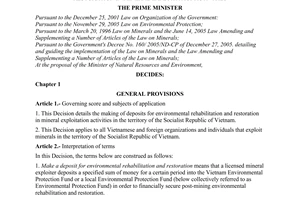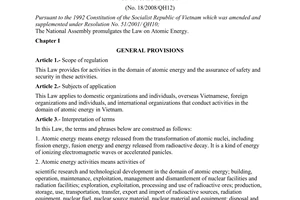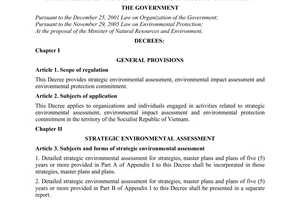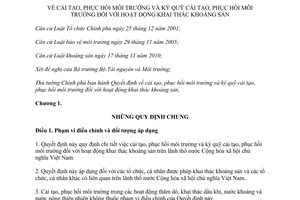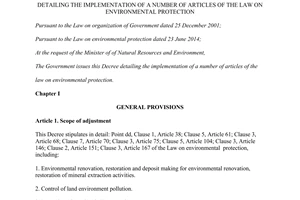Decision No. 18/2013/QD-TTg on environmental remediation and environmental remed đã được thay thế bởi Decree No. 19/2015/ND-CP detailing the Law on Environmental Protection và được áp dụng kể từ ngày 01/04/2015.
Nội dung toàn văn Decision No. 18/2013/QD-TTg on environmental remediation and environmental remed
|
THE PRIME
MINISTER |
SOCIALIST
REPUBLIC OF VIETNAM |
|
No. 18/2013/QD-TTg |
Hanoi, March 29th 2013 |
DECISION
ON ENVIRONMENTAL REMEDIATION AND ENVIRONMENTAL REMEDIATION DEPOSITS IN MINERAL EXTRACTION
Pursuant to the Law on Government organization dated December 25th 2001;
Pursuant to the Law on Environment protection dated November 29th 2005;
Pursuant to the Law on Mineral dated November 17th 2010;
At the request of the Minister of Natural Resources and Environment;
The Prime Minister issues a Decision on environmental remediation and environmental remediation deposits in mineral extraction,
Chapter 1.
GENERAL PROVISIONS
Article 1. Scope of regulation and subjects of application
1. This decision deals with environmental remediation and environmental remediation deposits in mineral extraction within the territory of the Socialist Republic of Vietnam.
2. This decision is applicable to organizations and individuals licensed to extract mineral extraction and involved organizations and individuals within the territory of the Socialist Republic of Vietnam.
3. Environmental remediation in the exploration and extraction of petroleum, mineral water and natural hot water is not or by this Decision.
Article 2. Interpretation of terms
In this Decision, the terms below are construed as follows:
1. Environmental remediation in mineral extraction means restoring the environment, ecosystem (earth, water, natural landscape, vegetation, etc.) in mineral extraction areas and areas impacted by mineral extraction close to their initial condition, or to reach the standards and regulations on safety and environment, and to serve the purposes beneficial to humans. 2. Environmental remediation deposits in mineral extraction are payments to Vietnam Environment Protection Fund or local environment protection funds where minerals are extracted (hereinafter referred to as environment protection funds) to ensure environmental remediation.
3. The environmental remediation projects are made by organizations and individuals engaged in mineral extraction in order to determine plans for environmental remediation and amount of money paid to environmental remediation funds , and submit them to competent authorities for approval (hereinafter referred to as projects)
4. Joint-mining areas are areas that have at least 02 adjacent mines and affect one another.
Chapter 2.
ENVIRONMENTAL REMEDIATION
Article 3. Requirements of environmental remediation
1. Ensure that the environment and ecosystems at mineral extraction areas and effected areas are restored close to their initial condition, or reach the standards and regulations on safety and environment, ensure the safety and serve the purposes beneficial to humans as prescribed in Appendix I to this Decision.
2. The environmental remediation is suitable for local socio-economic development plans, mineral extraction plans, land use and environment protection plans.
3. The environmental remediation is carried out during mineral extraction process.
4. The environmental remediation is suitable for the plans for environmental remediation made by People’s Committees of central-affiliated cities and provinces (hereinafter referred to as provincial People’s Committees) applicable to mineral extraction projects lies within joint-mining areas.
5. The environmental remediation in extraction of toxic minerals that contain radioactive materials must comply with the Law on Atomic Energy and relevant laws apart from complying with this Decision.
Article 4. Subjects of projects and supplementary projects
1. All organizations and individuals involved in mineral extraction shall make and submit plans to competent authorities for consideration and approval. In particular:
a) Organizations and individuals applying for Licenses for mineral extraction.
b) Organizations and individuals engaged in mineral extraction without approved plans for environmental remediation nor paying environmental remediation deposits.
2. The following subjects shall make supplementary environmental remediation projects (hereinafter referred to as supplementary projects):
a) Organizations and individuals requesting the adjustment of the Licenses for mineral extraction in terms of area, depth, and output.
b) Organizations and individuals applying for extension of Licenses for mineral extraction.
c) Organizations and individuals applying for changes in environmental remediation projects.
3. The projects are exempt in the following cases:
b) Organizations and individuals engaged in mineral extraction that have approved plans for environmental remediation or paid environmental remediation deposits as prescribed.
b) Organizations and individuals engaged in ordinary building material extraction as prescribed in Clause 2 Article 64 of the Law on Mineral.
Article 5. Process of making and submitting projects and supplementary projects
1. Time for making and submitting projects and supplementary projects:
a) Organizations and individuals prescribed in Point a Clause 1 Article 4 of this Decision shall make and submit projects to competent authorities for assessment together with the report on environmental impact assessment or the environment protection commitment as prescribed.
b) Organizations and individuals prescribed in Point b Clause 1 Article 4 of this Decision, apart from being penalized as prescribed by law, shall make and submit projects to competent authorities for assessment within 02 years from the effective date of this Decision.
c) Organizations and individuals prescribed Clause 2 Article 4 of this Decision shall make and submit supplementary projects to competent authorities for assessment before commencing the mineral extraction or being licensed to change the area, depth, output, or having the Licenses for mineral extraction extended, or changing the environmental remediation projects.
2. Dossier of application for the approval for a project or supplementary project:
a) The application for the approval for the project includes:
- The written request for the approval for the project;
- 09 descriptions of the project together with relevant drawings;
- The report on environmental impact assessment or environment protection commitment or registration of tax exemption standards or environment protection project together with the copy of the decision on approval or certificate (if any)
- Project of investment in mineral extraction together with the Decision to approve the project of investment, and the copy of the License for mineral extraction (if any).
b) The application for the approval for the supplementary project includes:
- The written request for the approval for the supplementary project;
- 09 descriptions of the supplementary project together with relevant drawings;
- The report on environmental impact assessment or environment protection commitment or registration of tax exemption standards or environment protection plan together with the copy of the decision on approval or certificate;
- Project of investment in mineral extraction together with the Decision to approve the project of investment and the copy of the License for mineral extraction (if any).
3. Contents of a project and supplementary project:
a) Project contents:
- Information about the mineral extraction project and legal basis for the plan;
- The extraction process, topographical and geomorphological characteristics; reserves of mines; mineral extraction works; condition of the environment and ecosystems in mineral extraction areas and the vicinity;
- Formulate and select an environmental remediation plan;
- Compile a list and calculate the volume of environmental remediation works according to the selected environmental remediation plan;
- Make an implementation and supervision program during the environmental remediation; a plan for inspecting and certifying the completion of environmental remediation;
- The plan for maintaining environmental remediation works:
- The amount of environmental remediation deposit and method of payment;
- Estimates of funding for each environmental remediation work according to the selected environmental remediation plan;
- Commitment on the standards of the environment, ecosystems, and quality of environmental remediation after the mineral extraction is done.
b) A supplementary project is composed of:
- General information about the mineral extraction project and legal basis for the supplementary project;
- Description and comparison of mineral extraction condition; natural conditions, topographical and geomorphological characteristics, and the ecosystems at the time of making the supplementary project; comparison the current natural landscape, the environment and ecosystems with those before the extraction;
- Formulate and select an environmental remediation plan;
- Compile a list and calculate the volume of supplementary environmental remediation works;
- Make an implementation and supervision program during the environmental remediation; a plan for inspecting and certifying the completion of environmental remediation;
- The plan for maintaining environmental remediation works:
- The amount of environmental remediation deposits and method of payment;
- Estimates of funding for each environmental remediation work according to the selected environmental remediation plan;
- Commitment on the standards of the environment, ecosystems, and quality of environmental remediation after the mineral extraction is done.
Article 6. Assessing and approving projects and supplementary projects
1. Authority to assess and approve projects:
a) The Ministry of Natural Resources and Environment shall assess and approve mineral extraction projects prescribed in Point a Clause 2 Article 18 of the Government's Decree No. 29/2011/ND-CP dated April 18th 2011 on strategic environmental assessment, environmental impact assessment, and environment protection commitment (hereinafter referred to as the Decree No. 29/2011/ND-CP).
b) Ministries, ministerial agencies, Governmental agencies shall assess and approve the projects prescribed in Point b and Point c Clause 2 Article 18 of the Decree No. 29/2011/ND-CP.
c) Provincial People’s Committees shall assess and approve the plans of mineral extraction projects prescribed in Point d Clause 2 Article 18 of the Decree No. 29/2011/ND-CP.
d) The Service of Natural Resources and Environment shall approve plans of local mineral extraction projects, except for those in Point a, Point b, and Point c of this Clause.
2. The authorities competent to assess and approve supplementary projects are the authorities competent to approve projects.
3. The assessment of projects or supplementary projects shall be carried out by assessment councils. Assessment councils shall assist competent authorities in examining the correctness of the legal basis, environmental remediation plans, and amount of payments to funds in projects or supplementary projects..
4. Assessment process:
a) Projects made by the organizations and individuals prescribed in Point a Clause 1 Article 4 of this Decision that have projects of investment in mineral extraction of which environmental impact assessment reports are compulsory shall be assessed together with eh environmental impact assessment reports as prescribed in the Decree No. 29/2011/ND-CP.
b) Projects made by the organizations and individuals prescribed in Point a Clause 1 Article 4 of this Decision that have projects of investment in mineral extraction of environment protection commitments are compulsory; projects and supplementary projects of the organizations and individuals prescribed in Point b Clause 1 and Clause 2 Article 4 of this Decision shall be assessed as follows:
- Within 05 days from the day on which the dossier of application for approval is received, the competent authority shall examine the adequacy and validity of the dossier. If the dossier is not complete or valid, competent authority shall request in writing the applicant to complete the dossier;
- After the valid dossier is received, the competent authority shall convene the assessment council, notify the assessment result to the applicant; within 30 days from the day on which the assessment council is convened, the applicant shall revise and complement the project or supplementary project and send it back to the competent authority for consideration and approval;
- While the project or supplementary project is being complemented at the request of the assessment council, the assessing authority may send request the applicant in writing or by email to keep complementing the unsatisfactory project or supplementary project.
- Within 15 days from the day on which the dossier is received, the competent authority shall decide to approve the project or supplementary project;
- After making the decision to approve the project or supplementary project, the approving authority shall make a written certification on the overleaf of the cover page, and send it to the applicant and involved units.
5. Deadline for assessing projects and supplementary projects:
a) Projects or supplementary projects within the competence of Ministries, ministerial agencies, and Governmental agencies shall be assessed within 45 days from the day on which the complete and valid dossier is received. The complicated environmental remediation projects shall be assessed within 60 days.
b) Projects or supplementary projects outside the competence of Ministries, ministerial agencies, and Governmental agencies shall be assessed within 30 days from the day on which the complete and valid dossier is received. The complicated environmental remediation projects shall be assessed within 45 days.
c) Assessing authorities may carry out field inspections before the assessment where necessary. The periods of survey and dossier complementation are not included in assessment period.
Chapter 3.
ENVIRONMENTAL REMEDIATION DEPOSITS AND METHOD OF PAYMENT
Article 7. Purposes and principles of deposits
1. Environmental remediation deposits are to ensure the participation of all organizations and individuals engaged in mineral extraction in environmental remediation as prescribed by law.
2. Deposit payment principles:
a) Organizations and individuals engaged in mineral extraction shall pay deposits to environment protection funds. Organizations and individuals engaged in mineral extraction in localities without environment protection funds shall pay deposits to Vietnam Environment Protection Fund.
b) Deposits shall be paid and refunded in VND.
c) Deposits shall enjoy demand deposit interest rates from the payment time.
d) Interest shall be withdrawn only once after having the Certificate of environmental remediation completion.
Article 8. Calculation of deposits
1. The total deposit equals the total expenditures on environmental remediation works in Appendix II to this Decision.
2. The expenditure on each environmental remediation works shall apply local unit prices at the time of making the project or supplementary project. If a locality does not provide unit prices, those of corresponding Ministries or areas shall apply.
3. Deposit period:
a) For new projects of investment in mineral extraction, the deposit periods depend on approved projects of investment in mineral extraction.
b) For licensed mineral extraction areas, the deposit periods depend on the remaining validity period of Licenses for mineral extraction..
c) Where the extraction period of a License for mineral extraction is different from that in the approved project or supplementary project, the amount of deposit shall be adjusted according to the issued License for mineral extraction and send it to the approving authority for consideration and adjustment.
Article 9. Method of deposit payment
1. For Licenses for mineral extraction with validity periods shorter than 03 years, deposits shall be paid once. The deposit is 100% of the approved amount.
2. For Licenses for mineral extraction with validity periods of 03 years or longer, deposits shall be paid in instalments as follows:
a) First deposit:
- For Licenses for mineral extraction with validity periods shorter than 10 years, the first deposit is 25% of the total deposit;
- For Licenses for mineral extraction with validity periods from 10 years to shorter than 20 years, first deposit payments are 20% of the total deposit;
- For Licenses for mineral extraction with validity periods of 20 years or longer, the first deposit is 15% of the total deposit;
b) The second deposit payment onwards equals the total deposit minus the first deposit and divided by the number of years according to the approved project of investment or the remaining time according to the License for mineral extraction.
3. Organizations and individuals may pay a lump sum of deposit.
Article 10. Order and procedure for paying and refunding deposits
1. Time of deposit payment:
a) Organizations and individuals licensed to extract minerals shall make the first deposit payment 30 days before commencing the extraction.
b) Where deposits are paid by instalments, the second payment onwards shall be made before January 30th of the year.
2. The deposit dossier is composed of:
a) The written application for paying a environmental remediation deposit.
b) The decision to approve the project or supplementary project.
3. Deposit refund:
a) Organizations and individuals engaged in mineral extraction that paid deposits shall have part or the whole deposits refunded.
b) The refund of deposit depends on the completion of each work in each stage of the project or supplementary project approved and certified by competent authorities.
4. The application for deposit refund includes:
a) The written request for refund of the deposit paid to environmental remediation funds.
b) Written certification of completion of one or all environmental remediation works.
5. Within 05 days, environment protection funds shall refund the deposit after the complete and valid dossier prescribed in Clause 4 of this Article is received.
Article 11. Management and use of deposits
1. Environment protection funds shall manage, use, and refund deposits within the law.
2. Where an organization or individual engaged in mineral extraction is bankrupt, the authority competent to approve the project or supplementary project shall use the deposit, including interest, for environmental remediation.
Chapter 4.
CERTIFICATION OF COMPLETION OF ENVIRONMENTAL REMEDIATION
Article 12. Application for the certification of completion of environmental remediation
1. After one or all environmental remediation works are completed according to the approved project or supplementary project, a report on the completion of environmental remediation (hereinafter referred to as report) shall be made and send to a competent authority for certification.
2. Report making principles:
a) For Licenses for mineral extraction with validity periods shorter than 03 years, 01 report and request for the certification of environmental remediation completion shall be made.
a) For Licenses for mineral extraction with validity periods 03 years or longer, reports and requests for the certification of completion of each work shall be made according to the approved project or supplementary project.
c) The environmental remediation works must ensure the quality and quantity according to standards, and be maintained in accordance with the approved project or supplementary project.
3. Report contents:
a) Legal basis of the report.
b) Completed environmental remediation works in accordance with the requirements, enclosed with an assessment of work quality and environment quality carried by the supervising authority.
c) The amount refunded corresponds to the value in cash of environmental remediation works in the approved project or supplementary project.
d) Consultation with the community is done in accordance with Article 15 of the Decree No. 29/2011/ND-CP.
4. The application for the certification of completion of environmental remediation
a) The written request for the certification of completion of environmental remediation,
b) 07 reports on the completion of environmental remediation.
c) 07 reports on the work quality assessment and environment quality assessment made by the supervising authority.
d) 01 copy of the project or supplementary project enclosed with the decision to approve.
Article 13. Inspection and certification of completion of environmental remediation
1. The authority competent to inspect and certify the completion of environmental remediation is the authority that approved the project or supplementary project.
2. The certificate of environmental remediation completion is the basis for beginning the procedures for closing the mine, handing over land and environmental remediation works to the local government as prescribed.
3. Certification procedure:
a) The certification of environmental remediation completion is done by field inspection participated by involved organizations.
b) Inspection and certification procedure:
- Within 05 days from the day on which the dossier is received, the competent authority shall examine the adequacy and validity of the dossier and request the applicant to make supplementation if the dossier is not complete or valid;
- Within 30 days from the day on which the complete and valid dossier is received, the competent authority shall establish a Inspectorate to verify the completion of the project or supplementary project. The Inspectorate includes: representatives of the local government, representative of local Natural Resources and Environment Agency, the authority that issued the License for mineral extraction, environment protection fund to which the deposit is paid. The competent authority may invite some relevant units and agencies in charge of supervising environmental remediation work quality and environment quality to join the Inspectorate;
- After the inspection result is given, the competent authority shall send a written notification of the inspection result to the applicant;
- Within 15 days after the written notification of the inspection result is made of after the complete dossier is received in case supplementation must be made at the request of the Inspectorate, the competent authority shall issue the Certificate of environmental remediation completion.
4. Inspection contents:
a) Compare each environmental remediation works with the report submitted by the applicant.
b) Compare the volume, quality, and maintenance of environmental remediation works with the claims in the project or supplementary project, the design dossier, and applicable standards.
Chapter 5.
RESPONSIBILITIES OF GOVERNING AUTHORITIES AND UNITS
Article 14. Responsibilities of the Ministry of Natural Resources and Environment
1. Cooperate with other Ministries, ministerial agencies, Governmental agencies, and provincial People’s Committees in providing guidance and inspecting the implementation of this Decision.
2. Formulate and issue legislative documents and instructions on environmental remediation and environmental remediation deposits in mineral extraction.
3. Grant approval for projects and supplementary projects, verify and certify the completion of environmental remediation within their competence.
4. Formulate and issue legislative documents on environment protection and environmental remediation in mineral extraction and joint-mining as prescribed.
5. Cooperate with other Ministries, ministerial agencies, Governmental agencies, and provincial People’s Committees in identifying the areas impacted by the extraction of hazardous minerals that contain radioactive materials; assess the impact of extraction of hazardous minerals that contain radioactive materials on the environment and human.
6. Inspect the environment protection, environmental remediation, and deposit payment annually within their competence.
Article 15. Responsibilities of other Ministries, ministerial agencies, and Governmental agencies
1. Grant approval for projects and supplementary projects, verify and certify the completion of environmental remediation within their competence.
2. Provide instruction and inspect the environmental remediation and environmental remediation deposit payments of organizations and individuals engaged in mineral extraction within their competence.
3. Penalize violations against the laws on environmental remediation and environmental remediation deposit payment within their competence.
4. Report the environmental remediation result and environmental remediation deposit payment to the Ministry of Natural Resources and Environment before December 31st every year.
Article 16. Provincial People’s Committees
1. Grant approval, verify and certify the completion of environmental remediation according to project or supplementary project within their competence.
2. Make plans for land use after mineral extraction; plans for remediation or the environment in local joint-mining areas.
3. Provide instructions inspect the environmental remediation and environmental remediation deposit payments of organizations and individuals engaged in mineral extraction within their competence.
4. Report the environmental remediation result and environmental remediation deposit payment; the management and use of deposits and environment protection fees to the Ministry of Natural Resources and Environment before December 31st every year.
Article 17. Responsibilities of environment protection funds
1. Receive deposits from organizations and individuals engaged in mineral extraction.
2. Certify the deposits and request competent authorities to approve projects or supplementary projects.
3. Refund the deposits and pay interests on deposits to organizations and individuals as prescribed.
4. Take responsibility for the management and use of deposits in accordance with law. Report the management, use, and refund of deposits to provincial People’s Committees and the Ministry of Natural Resources and Environment every year.
5. Remind organizations and individuals engaged in mineral extraction to pays deposits punctually. Request competent authorities to penalize violations against regulations on deposit payment.
Article 18. Responsibilities of organizations and individuals engaged in mineral extraction.
1. Make and submit projects and supplementary projects to competent authorities for approval.
2. Provide the contents of approved projects and supplementary projects to the public via commune-level People’s Committees and Fatherland Front Committees.
3. Complete all environmental remediation works and pay deposits in accordance with approved projects and supplementary projects.
4. Pay fees for assessment, inspection, and certification of the completion of projects and supplementary projects as prescribed.
5. Report the environmental remediation results and environmental remediation deposit payment to the authorities that approved projects or supplementary projects and local environment protection agencies before December 31st every year.
Chapter 6.
IMPLEMENTATION
Article 19. Effect
This Decision takes effect on May 15th 2013 and supersedes the Decision No. 71/2008/QD-TTg dated May 29th 2008 of the Prime Minister on environmental remediation deposit payment in mineral extraction.
Article 20. Implementation organization
1. The Ministry of Natural Resources and Environment shall cooperate with other Ministries, ministerial agencies, Governmental agencies, and provincial People’s Committees in providing guidance and organizing the implementation of this Decision.
2. Ministers, Heads of ministerial agencies, Heads of Governmental agencies, the Presidents of People’s Committees of central-affiliated cities and provinces, organizations and individuals engaged in mineral extraction, environment protection funds, organizations and individuals involved are responsible for the implementation of this Decision.
|
|
THE PRIME
MINISTER |
------------------------------------------------------------------------------------------------------
This translation is made by LawSoft and
for reference purposes only. Its copyright is owned by LawSoft
and protected under Clause 2, Article 14 of the Law on Intellectual Property.Your comments are always welcomed


